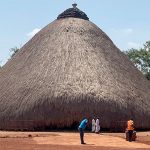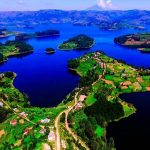The Ugandans were hunter-gatherers until 1,700 to 2,300 years ago. Bantu-speaking populations, who were probably from central Africa, migrated to the southern parts of the country. These groups brought and developed ironworking skills and new ideas of social and political organization.
The Empire of Kitara covered most of the great lakes area, from Lake Albert, Lake Tanganyika, Lake Victoria, to Lake Kyoga. Its leadership headquarters were mainly in what became Ankole, believed to have been run by the Bachwezi dynasty in the fourteenth and fifteenth centuries, who may have followed a semi-legendary dynasty known as the Batembuzi. Bunyoro-Kitara is claimed as the antecedent of later kingdoms; Buganda, Toro, Ankole and Busoga. The Nilotic Luo invasion is believed to have led to the collapse of the Chwezi Empire. The twins Rukidi Mpuuga and Kato Kintu are believed to be the first kings of Bunyoro and Buganda after the Chwezi Empire collapsed, creating the Babiito and Bambejja Dynasty.
The Nilotic people including Luo and Ateker entered the area from the north, probably beginning about A.D. 120. They were cattle herders and subsistence farmers who settled mainly in the northern and eastern parts of the country. Some Luo invaded the area of Bunyoro and assimilated with the Bantu there, establishing the Babiito dynasty of the current Omukama (ruler) of Bunyoro-Kitara. The Luo migration continued until the 16th century, with some Luo settling amid Bantu people in Eastern Uganda, with others proceeding to the eastern shores of Lake Victoria in Kenya and Tanzania. The Ateker (Karamojong and Iteso) settled in the northeastern and eastern parts of the country, and some fused with the Luo in the area north of Lake Kyoga.
Arab traders moved inland from the Indian Ocean coast of East Africa in the 1830s. They were followed in the 1860s by British explorers searching for the source of the Nile. Protestant missionaries entered the country in 1877, followed by Catholic missionaries in 1879. The United Kingdom placed the area under the charter of the British East Africa Company in 1888, and ruled it as a protectorate from 1894.
In the 1890s, 32,000 labourers from British India were brought to East Africa under indentured labour contracts to work on the construction of the Uganda Railway. Most of the surviving Indians returned home, but 6,724 decided to remain in East Africa after the line’s completion.
As several other territories and chiefdoms were integrated, the final protectorate called Uganda took shape in 1914. From 1900 to 1920, a sleeping sickness epidemic killed more than 250,000 people, about two-thirds of the population in the affected lake-shore areas.
Uganda gained independence from Britain in 1962, maintaining its Commonwealth membership. The first post-independence election, held in 1962, was won by an alliance between the Uganda People’s Congress (UPC) and Kabaka Yekka (KY). UPC and KY formed the first post-independence government with Milton Obote as executive Prime Minister, the Buganda Kabaka (King) Edward Mutesa II holding the largely ceremonial position of President and William Wilberforce Nadiope, the Kyabazinga (paramount chief) of Busoga, as Vice President.
In 1966, following a power struggle between the Obote-led government and King Mutesa, the UPC-dominated Parliament changed the constitution and removed the ceremonial president and vice president. In 1967, a new constitution proclaimed Uganda a republic and abolished the traditional kingdoms. Without first calling elections, Obote was declared the executive President.
After a military coup in 1971, Obote was deposed from power and the dictator Idi Amin seized control of the country. Amin ruled Uganda with the military for the next eight years and carried out mass killings within the country to maintain his rule. An estimated 300,000 Ugandans lost their lives at the hands of his regime. Aside from his brutalities, he forcibly removed the entrepreneurial South Asian minority from Uganda, which left the country’s economy in ruins. Amin’s atrocities were graphically accounted in the 1977 book, “A State of Blood,” which was written by one of his former ministers after he fled the country.
Amin’s reign was ended after the Uganda-Tanzania War in 1979 in which Tanzanian forces aided by Ugandan exiles invaded Uganda. This led to the return of Obote, who was deposed once more in 1985 by General Tito Okello. Okello ruled for six months until he was deposed after the so-called “bush war” by the National Resistance Army (NRA) operating under the leadership of the current president, Yoweri Museveni, and various rebel groups, including the Federal Democratic Movement of Andrew Kayiira, and another belonging to John Nkwaanga.
Museveni has been in power since 1986. In the mid- to late 1990s, he was lauded by the West as part of a new generation of African leaders. His presidency has included involvement in the civil war in the Democratic Republic of Congo (DRC) and other conflicts in the Great Lakes region, as well as the civil war against the Lord’s Resistance Army, which has been guilty of numerous crimes against humanity including child slavery and mass murder. Conflict in northern Uganda has killed thousands and displaced millions.
















